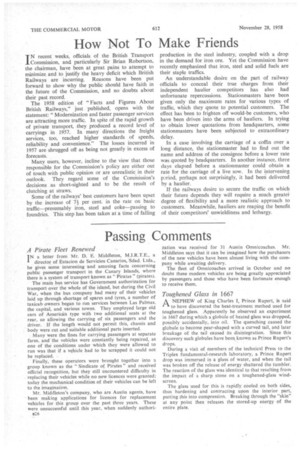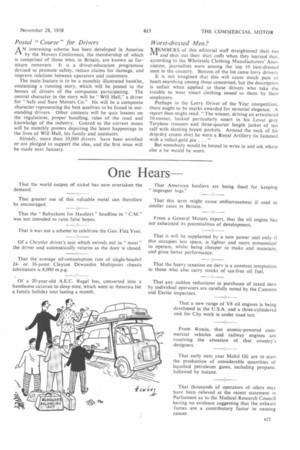Passing Comments
Page 32

Page 33

If you've noticed an error in this article please click here to report it so we can fix it.
A Pirate Fleet Renewed
I N a letter from Mr. D. E. Middleton, M.I.R.T.E., a director of E,stacion de Servicios Canarios, Sdad. Ltda., he gives some interesting 'and amusing facts concerning public passenger transport in the Canary Islands, where there is a system of transport known as " Piratas " (pirates).
The main bus service has Government authorization for transport over the whole of the island, but during the Civil War, when the bus company had many of their vehicles laid up through shortage of spares and tyres, a number of taxicab owners began to run services between Las Palmas, the capital, and various towns. They employed large old cars of American type with two additional seats at the rear, so allowing the carrying of six passengers and the driver. If the length would not permit this, chassis and body were cut and suitable additional parts inserted.
Many were the fines for carrying passengers at separate fares, and the vehicles were constantly being repaired, as one of the conditions under which they were allowed to run was that if a vehicle had to be scrapped it could not be replaced.
Finally, these operators were brought together into a group known as the " Sindicate of Pirates" and received official recognition, but they still encountered difficulty in replacing their vehicles while no new licences were granted; today the mechanical condition of their vehicles can be left to the imagination.
Mr. Middleton's company, who are Austin agents, have been making applications for licences for replacement vehicles for this group over the past three years. These were unsuccessful until this year, when suddenly authori B26 zation was received for 31 Austin Omnicoaches. Mr. Middleton says that it can be imagined how the purchasers of the new vehicles have been almost living with the company while awaiting delivery.
The fleet of Omnicoaches arrived in October and no doubt these modern vehicles are being greatly appreciated by passengers and those who have been fortunate enough to receive them.
Toughened Glass in 1667
A NEPHEW of King Charles I, Prince Rupert, is said " to have discovered the heat-treatment method used for toughened glass. Apparently he observed an experiment in 1667 during which a globule of heated glass was dropped, possibly accidentally, into oil. The quenching caused the globule to become pear-shaped with a curved tail, and later breakage of the tail caused its disintegration. Since this discovery such globules have been known as Prince Rupert's drops.
During a visit of members of the technical Press to the Triplex fundamental-research laboratory, a Prince Rupert drop was immersed in a glass of water, and when the tail was broken off the release of energy shattered the tumbler. The reaction of the glass was identical to that resulting from the impact of a sharp stone on a toughened-glass windscreen.
The glass used for this is rapidly cooled on both sides, thus hardening and contracting upon the interior part, putting this into compression. Breaking through the "skin" at any point then releases the stored-up energy of the entire plate.
Postal "Course" for Drivers
AN interesting scheme has been developed in America by the Movers Conference, the membership of which is comprised of those who, in Britain, are known as furniture removers. It is a driver-education programme devised to promote safety, reduce claims for damage, and improve relations between operators and customers.
The main feature is to be a monthly illustrated booklet, containing a running story, which will be posted to the homes of drivers of the companies participating. The central character in the story will be "Will Hall," a driver for "Safe and Sure Movers Co." He will be a composite character representing the best qualities to be found in outstanding drivers. Other contents will be quiz lessons on the regulations, proper handling, rules of the road and knowledge of the industry. Geared to the current issues will be monthly posters depicting the latest happenings in the lives of Will Hall, his family and assistants.
Already, more than 10,000 drivers have been enrolled or are pledged to support the idea, and the first issue will be made next January.
Worst-dressed Men?
MEMBERS of this editorial staff straightened their ties 1". and shot out their shirt cuffs when they learned that, according to the Wholesale Clothing Manufacturers' Association, journalists were among the top 10. best-dressed men in the country. Bottom of the list came lorry drivers.
It is not imagined that this will cause much pain or heart-searching among those concerned, but the description is unfair when applied to those drivers who take the trouble to wear smart clothing issued to them by their employers.
Perhaps in the Lorry Driver of the Year competition, there ought to be marks awarded for sartorial elegance. A report then might read: "The winner, driving an articulated 10-tonner, looked particularly smart in his Lovat grey Terylene trousers and three-quarter length jacket of tan calf with slanting breast pockets. Around the neck of his drip-dry cream shirt he wore a Royal Artillery tie fastened with a rolled-gold pin .
But somebody would be bound to write in and ask where else a tie would be worn.












































































































